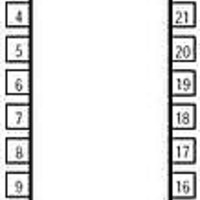MAX3107EAG+ Maxim Integrated Products, MAX3107EAG+ Datasheet - Page 16

MAX3107EAG+
Manufacturer Part Number
MAX3107EAG+
Description
IC UART SPI/I2C 128 FIFO 24SSOP
Manufacturer
Maxim Integrated Products
Datasheet
1.MAX3107EAG.pdf
(52 pages)
Specifications of MAX3107EAG+
Features
Internal Oscillators
Number Of Channels
4, QUART
Fifo's
128 Byte
Protocol
RS232, RS485
Voltage - Supply
2.35 V ~ 3.6 V
With Auto Flow Control
Yes
With Irda Encoder/decoder
Yes
With False Start Bit Detection
Yes
Mounting Type
Surface Mount
Package / Case
24-SSOP
Data Rate
24 Mbps
Supply Voltage (max)
3.6 V
Supply Voltage (min)
1.71 V
Supply Current
4 mA
Maximum Operating Temperature
+ 85 C
Minimum Operating Temperature
- 40 C
Mounting Style
SMD/SMT
Lead Free Status / RoHS Status
Lead free / RoHS Compliant
SPI/I
and Internal Oscillator
Figure 4. Receive Data Format
Figure 5. Midbit Sampling
To halt transmission, set MODE1[1]: TxDisabl to 1. After
MODE1[1] is set, the transmitter completes transmission
of the current character and then ceases transmission.
The TX output logic can be inverted through IrDA[5]:
TxInv. If not stated otherwise, all transmitter logic
described in this data sheet assumes IrDA[5] is 0.
The receiver expects the format of the data at RX to be
as shown in Figure 4. The quiescent logic state is a high
and the first bit (the START bit) is logic-low. The receiver
samples the data near the midbit instant (Figure 4). The
received words and their associated errors are depos-
ited into the receive FIFO. Errors and status information
are stored for every received word (Figure 6). The host
reads data out of the receive FIFO through the Receive
Holding register (RHR), oldest data first. The status
information of the current word in the RHR is located in
the Line Status register (LSR). After a word is read out
of the RHR, the LSR contains the status information for
that word.
The following three error conditions are determined for
each received word: parity error, framing error, and
noise on the line. Line noise is detected by checking the
consistency of the logic of the three samples (Figure 5).
The receiver can be turned off through MODE1[0]:
RxDisabl. When this bit is set to 1, the MAX3107 turns the
receiver off immediately following the current word and
16
RECEIVED DATA
_____________________________________________________________________________________
BLOCK
BAUD
SAMPLING
MIDDATA
RX
2
C UART with 128-Word FIFOs
A
1
START
2
3
Receiver Operation
LSB
D0
4
D1
5
6
D2
7
D3
8
ONE BIT PERIOD
does not receive any further data. The RX input logic can
be inverted through IrDA[4]: RxInv.
When operating in standard (i.e., not 2x or 4x rate) mode,
the MAX3107 checks that the binary logic level of the
three samples per received bit are identical. If any of
the three samples have differing logic levels, then noise
on the transmission line has affected the received data
and is considered to be noisy. This noise indication is
reflected in the LSR[5]: RxNoise bit for each received
byte. Parity errors are another indication of noise, but are
not as sensitive.
The MAX3107 can be clocked by its internal oscillator,
an external crystal, or an external clock source. Figure 7
shows a simplified diagram of the clocking circuitry.
When the MAX3107 is clocked by the internal oscillator
or a crystal, the STSInt[5]: ClockReady indicates when
the clocks have settled and the baud-rate generator is
ready for stable operation.
The baud-rate clock can be routed to the RTS/CLKOUT
output. The clock rate is 16x the baud rate in standard
operating mode, and 8x the baud rate in 2x rate mode.
In 4x rate mode, the CLKOUT frequency is 4x the
programmed baud rate. If the fractional portion of the
baud-rate generator is used, the clock is not regular and
exhibits jitter.
9
D4
10
MAJORITY
SAMPLER
CENTER
D5
Clocking and Baud-Rate Generation
11
D6
12
13
MSB
D7
14
Line Noise Indication
PARITY
15
16
STOP
STOP











